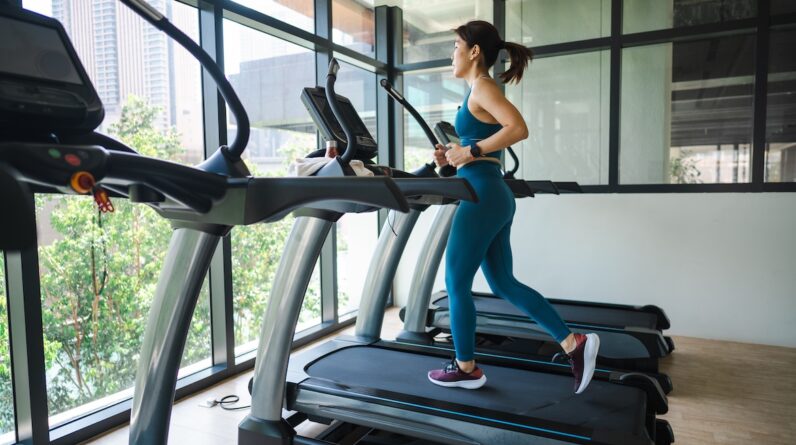
The truth is, honestly, far less climactic: Doing cardio after leg day is A-OK, but it’s not a magic bullet to any major benefits—and it may come with some minor risks, depending on your goals. So forget whatever you heard on TikTok. We’re breaking down the actual science below.
Can you do cardio after leg day?
If you typically follow up a lower-body strength workout with a light jog, stair climbing, or treadmill strut, the good news is that you’re doing nothing wrong.
You can absolutely do cardio after leg day, says Dan Churchill, MS, trainer and performance chef with Centr. “I would recommend keeping the intensity on the low to moderate side and not aim to do an intense cardio session right after a brutal leg session, but because your muscles will be warmed up by this point, it’s safe and can even be helpful to work in cardio after strength.”
Rumors that cardio will hurt your muscle gains or have other adverse effects don’t hold up. To be fair, though, the idea that doing cardio after strength is bad didn’t come out of nowhere. “We previously assumed that a bout of aerobic exercise that immediately followed a strength training workout would impair the mTOR signaling pathway (the metabolic pathway stimulated by strength training that stimulates muscle growth),” explains Luke Carlson, MS, CEP, certified exercise physiologist and CEO and founder of Discover Strength. “However, we have very little research to confirm this.”
For example, a 2022 research review1 published in Sports Medicine found that combining aerobic and strength training doesn’t compromise muscle hypertrophy or maximal strength development, even when included in the same session. (The researchers did find that doing both in the same workout slightly affected explosive strength gains, which may be important to note if you’re training for a power sport or building a related skill.)
TL;DR: if your goal with a leg-day workout is to maximize muscle strength or increase muscle size, it’s fine to do cardio afterward, Carlson says.
Benefits of doing cardio after leg day
Aerobic exercise, in general, comes with a lot of fantastic health perks that make it essential to include in your workout routine, even if you’re mainly focused on strength work.
“All cardio has tremendous and varying benefits for your performance and recovery,” Churchill says. “If you can target two to three hours of zone 2 (i.e., moderate-intensity) cardio a week, and then some efforts at high intensity, it’s a good combination to build your speed, endurance, and improve longevity health.” Moderate-intensity aerobic training can boost heart health2, improve your mental health3 and brain function4, improve overall quality of life5, and reduce total early mortality risk6—and this is just scratching the surface of cardio’s health benefits.
However, doing cardio after leg day, specifically, doesn’t dramatically change how it affects your body. “Beyond the customary cardiorespiratory adaptations and chronic disease protection benefits, there is probably no benefit of doing cardio immediately after a leg strength workout,” Carlson says.
Some people say that doing light cardio after strength work can help with recovery or reduce delayed-onset muscle soreness (DOMS), but for now, we just don’t have evidence to back up that claim. “Cardio does not impact recovery, positively or negatively, following an intense strength workout,” Carlson says.
Even if post-strength cardio doesn’t have a marked effect on soreness or recovery, the American College of Sports Medicine (ACSM) still recommends performing at least a few minutes of low-intensity aerobic exercise after a workout as a way to cool down. This helps you gradually decrease your heart rate and blood pressure and circulate cellular waste products that accumulate in muscles during exercise, according to the ACSM. So, if you’re doing gentle cardio to wind down from an intense lifting session, there is some benefit there.
Potential risks of doing cardio after leg day
We repeat: In general, doing cardio after a leg strength workout is no problem, but there are some potential downsides to know about.
For one, if your muscles are pretty fatigued after a lower-body lifting session, tacking on a high-intensity cardio workout like a sprint workout or aggressive indoor cycling class could put you at risk of injury. “If we train the legs hard and then transition into a run, we might be at a greater susceptibility to injury during the run,” Carlson says.
Another downside of doing cardio after leg day is that it could hinder your cardio performance. If you’re hopping on a tread as a post-workout cooldown or just to meet your cardio quota, that might be fine—but if your main fitness goal is cardio-focused, prioritizing strength above cardio could have negative repercussions.
“For example, if you’re a distance runner training for an upcoming half marathon, performing a strength-training workout immediately before your key running workout will compromise your ability to execute that run,” Carlson says.
A 2016 study7 in the Journal of Strength and Conditioning Research shows that separating your workouts by at least six hours diminishes the potential interference effects, but doing them on separate days is even better. “Thus, if your goal is to prepare for an endurance event, either schedule the cardio before the strength workout or on a non-strength training day,” Carlson says.
There’s one exception: If you’re training for a competition that requires both strength and cardio, such as Hyrox or an obstacle race, doing cardio post-strength is a great way to simulate running under fatigued legs, Churchill says. “But it is important to note that overdoing this can lead to injury,” he adds. “I would only recommend doing this if you are an advanced runner. If you’re just starting, I’d allow time for rest in between.”
The best type of cardio to do after leg day
As Churchill mentioned above, the most important thing to consider is your level of exertion. It doesn’t matter as much whether you’re hopping on the elliptical, walking or running on a tread, cycling, or stair climbing but it’s best to keep post-leg-day cardio to a low or moderate intensity to reduce any risk of injury.
That entails working at an effort level of six (or less) out of 10, where zero is the level of effort required to sit and 10 is giving it your maximal effort, according to the Centers for Disease Control and Prevention (CDC). You can also use the “talk test” to gauge your aerobic exercise intensity: If you can talk during your workout but not sing, that means you’re hovering around moderate intensity. If you can’t say more than a few words without pausing for a breath, you’re working at a vigorous intensity.
How to recover after leg day
It might be a bummer to hear that some post-leg day cardio doesn’t help reduce your DOMS. If it feels good to you to get blood pumping after you’ve torched your legs, that’s reason enough to keep doing it—just factor in these other recovery tips to help facilitate muscle growth and repair.
“The biggest influences on recovery following intense strength training are adequate protein and adequate sleep,” Carlson says. Daily protein intake between 1.2 to 2 grams per kilogram of body weight is generally enough to support post-workout recovery, according to a joint statement8 from the ACSM, American Academy of Nutrition and Dietetics, and Dietitians of Canada. As for sleep, the ACSM recommends getting at least eight hours a night for optimal recovery. Certain people may need even more sleep9 or protein, depending on their body, lifestyle, and goals.
Other research-backed recovery methods10 include massage, compression garments, contrast water therapy, cryotherapy, and active recovery (i.e., going for a walk). “I’m a big believer in contrast therapy, and getting in compression boots,” Churchill adds. Massage seems to be the most effective at reducing DOMS and perceived fatigue, and you can get the perks on your own with massage tools like a foam roller or lacrosse ball.
If you have wildly, terribly sore muscles to the point where you can’t walk for days, it may be a sign you’re doing too much too fast. “If your goal is to mitigate DOMS, you can also avoid novelty and variety in the workout since soreness is largely caused by doing something new,” Carlson says.
Honestly, that’s another perk of doing aerobic work right after your leg workout: If you know you’ll be sore in the days following a challenging leg workout, it might be wise to get your cardio done while you can still walk.
Well+Good articles reference scientific, reliable, recent, robust studies to back up the information we share. You can trust us along your wellness journey.
- Schumann M, Feuerbacher JF, Sünkeler M, Freitag N, Rønnestad BR, Doma K, Lundberg TR. Compatibility of Concurrent Aerobic and Strength Training for Skeletal Muscle Size and Function: An Updated Systematic Review and Meta-Analysis. Sports Med. 2022 Mar;52(3):601-612. doi: 10.1007/s40279-021-01587-7. Epub 2021 Nov 10. PMID: 34757594; PMCID: PMC8891239.
- Pinckard K, Baskin KK, Stanford KI. Effects of Exercise to Improve Cardiovascular Health. Front Cardiovasc Med. 2019 Jun 4;6:69. doi: 10.3389/fcvm.2019.00069. PMID: 31214598; PMCID: PMC6557987.
- Gilani SRM, Feizabad AK. The effects of aerobic exercise training on mental health and self-esteem of type 2 diabetes mellitus patients. Health Psychol Res. 2019 Mar 11;7(1):6576. doi: 10.4081/hpr.2019.6576. PMID: 30997432; PMCID: PMC6441819.
- Guiney H, Machado L. Benefits of regular aerobic exercise for executive functioning in healthy populations. Psychon Bull Rev. 2013 Feb;20(1):73-86. doi: 10.3758/s13423-012-0345-4. PMID: 23229442.
- Adams V, Linke A. Impact of exercise training on cardiovascular disease and risk. Biochim Biophys Acta Mol Basis Dis. 2019 Apr 1;1865(4):728-734. doi: 10.1016/j.bbadis.2018.08.019. Epub 2018 Aug 28. PMID: 30837069.
- Millenaar D, Böhm M, Mahfoud F. Risk prediction with blood pressure during physical activity: A METter of exercise? Eur J Prev Cardiol. 2020 Jun;27(9):975-977. doi: 10.1177/2047487319885038. Epub 2019 Oct 26. PMID: 31657223.
- Robineau J, Babault N, Piscione J, Lacome M, Bigard AX. Specific Training Effects of Concurrent Aerobic and Strength Exercises Depend on Recovery Duration. J Strength Cond Res. 2016 Mar;30(3):672-83. doi: 10.1519/JSC.0000000000000798. PMID: 25546450.
- Thomas DT, Erdman KA, Burke LM. American College of Sports Medicine Joint Position Statement. Nutrition and Athletic Performance. Med Sci Sports Exerc. 2016 Mar;48(3):543-68. doi: 10.1249/MSS.0000000000000852. Erratum in: Med Sci Sports Exerc. 2017 Jan;49(1):222. doi: 10.1249/MSS.0000000000001162. PMID: 26891166.
- Dupuy O, Douzi W, Theurot D, Bosquet L, Dugué B. An Evidence-Based Approach for Choosing Post-exercise Recovery Techniques to Reduce Markers of Muscle Damage, Soreness, Fatigue, and Inflammation: A Systematic Review With Meta-Analysis. Front Physiol. 2018 Apr 26;9:403. doi: 10.3389/fphys.2018.00403. PMID: 29755363; PMCID: PMC5932411.
- Doherty R, Madigan SM, Nevill A, Warrington G, Ellis JG. The Sleep and Recovery Practices of Athletes. Nutrients. 2021 Apr 17;13(4):1330. doi: 10.3390/nu13041330. PMID: 33920560; PMCID: PMC8072992.







